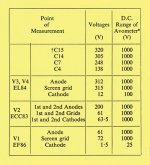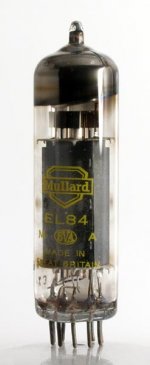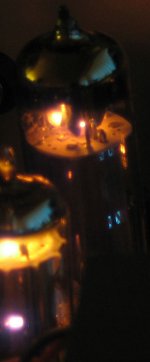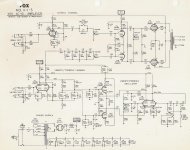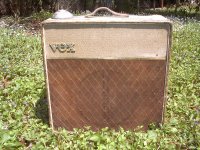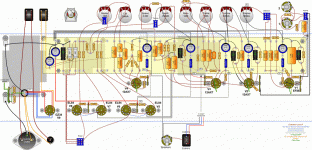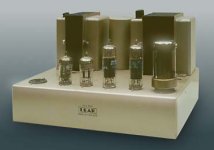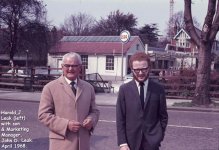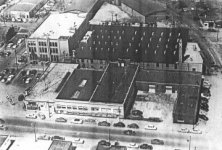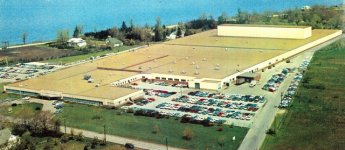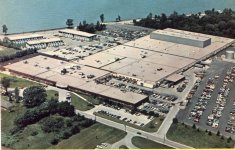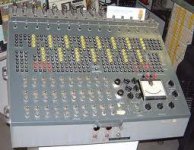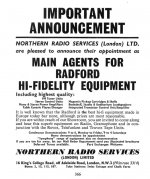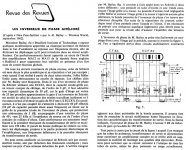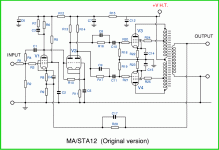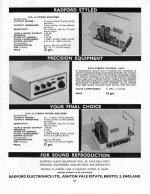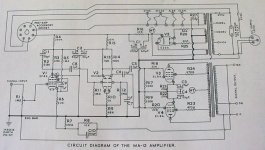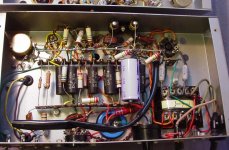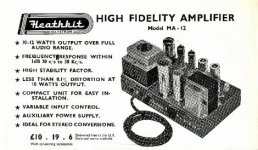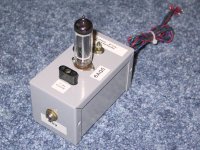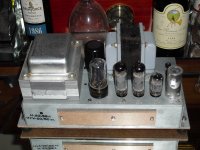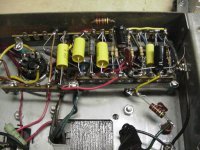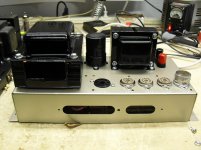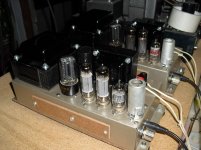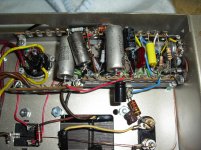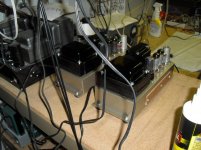Firefox told me it was 'embarressed'
That used to happen all the time XP.
Hope your OK Jeff and nothings happened like a catastrophic stay snaping crash or anything, am just asking as I burnt my baked potato last night while trying to get back on the 666 (sorry, typo) WWW last night.
Haven't had a serious crash in a couple of years. They usually involve interactions with cars or pick-up trucks.😱
Funny you should mention the GEC 912-plus, I downloaded the GEC book of tube amps from Pete Millett's exellent site yesterday (haven't had a chance to look at it yet but I guess the 912 might be in there).
Got any pics of it ?
No, I was hoping you had a pic. I have a copy of that book from Audio Amateur Press. The amp is in chapter 3.
The bass & treb use 2 Meg!!! pots, and the vol 1 Meg!!!, so would probably have to be stepped, as me thinks decent pots may be hard to get (I think they're doing this so the EQ caps are very small).
Personally, I would skip the EQ stage.
jeff
According to most data sheets I've seen the EL84/6BQ5 is only good for 300 V on the plates and screens. The schematic for the AA-151 here shows 355 V on the plates, and 360 V on the screens - Yikes! All I can figure is either the plate current is low, or those poor tubes are being beat to death!
Am I missing something here?
Hi Mr. Zenith
I seem to remember a comment by someone I used to work with years ago suggesting that the EL84 could be pushed way beyond it's usual operating parameters.
Have enclosed the 1961 & 1964 Mullard datasheets here.
They present operating graphs for both 250v & 300v.
So 355-360v is a bit above their expected application levels.
They also state the limiting value for the EL84 as 550v.
So maybe my old work mate was right. This is a very robust tube for it's size.
Looks like there's a fair amount of headroom here.
Maybe this has something to do with how good it sounds at an average level.
The EL84's in the amps I have here do get fairly hot at the 315v of Mullard's own design.
I was once told the VOX amps loved by The Beatles ran a lot of EL84's.
I haven't checked this in any VOX schematics, but in view of the limiting value of 550v stated in Mullard's 1960's datasheets, they may have run them even higher than Heathkit in the AA-151.
Thanks for pointing this out, as the user of the re-boxed AA-151 (photos earlier in this thread) seems delighted with the sound of it and seems to love the EL84 in general.
I assume their amp is running 360v from the original Heathkit transformer.
Might be worth checking out what VOX did and cranking it up a bit on my refurb.
I will certainly be fitting 450v components just in case.
Cheers...Simon...


The EL84 glows BLUE when operating.
Those clever boffins at Mullard predated the trendy blue LED by 50 years !
Attachments
Two EL84's in the VOX AC-15 amplifier.
Thanks Mr. Zenith
Your comments on the EL84's driven to the max, reminded me of the VOX EL84 amps.
Did a bit of research today on 'The Jennings Organ Co' VOX AC-15.
2x EL84's with EF86 input tube, and an ECC83 thrown in as well, Great !
VOX seem to be stateing their output at 15w, 5w higher than the Mullard 5-10, and 3w higher than the Heathkit MA-12.
No transformer feedback on the VOX AC-15 either.
Do you have any favorite EL84 amps Mr. Zenith ?
Cheers...Simon...😀
Yikes! All I can figure is either the plate current is low, or those poor tubes are being beat to death!
Thanks Mr. Zenith
Your comments on the EL84's driven to the max, reminded me of the VOX EL84 amps.
Did a bit of research today on 'The Jennings Organ Co' VOX AC-15.
2x EL84's with EF86 input tube, and an ECC83 thrown in as well, Great !
VOX seem to be stateing their output at 15w, 5w higher than the Mullard 5-10, and 3w higher than the Heathkit MA-12.
No transformer feedback on the VOX AC-15 either.
Do you have any favorite EL84 amps Mr. Zenith ?
Cheers...Simon...😀
Attachments
Another 2x EL84 Amp - The Leak TL/20 Plus.
The Leak 'TL/20 Plus', another nice little EL84 amplifier made in West London in the swinging sixties.
I was hoping you had a pic. jeff
The Leak 'TL/20 Plus', another nice little EL84 amplifier made in West London in the swinging sixties.
Attachments
Heathkit expanded to meet the needs of the electronics diyer.
Heathkits first major DIY success story was their late 1940's oscilloscope kit based on WWII surplus CRT tubes.
The keen diyer could build their own high quality oscilloscope at a fraction of the cost of a ready made one.
The scope kit was hugely popular, and the profits fueled the companys expansion to a larger factory.
Business boomed for Heathkit throughout the 50's 60's & 70's, promoting further expansion of their new factory.
Heathkits problems came when taking on the DIY computer market, here's one of the early analogue computer kits.
Heathkits first major DIY success story was their late 1940's oscilloscope kit based on WWII surplus CRT tubes.
The keen diyer could build their own high quality oscilloscope at a fraction of the cost of a ready made one.
The scope kit was hugely popular, and the profits fueled the companys expansion to a larger factory.
Business boomed for Heathkit throughout the 50's 60's & 70's, promoting further expansion of their new factory.
Heathkits problems came when taking on the DIY computer market, here's one of the early analogue computer kits.
Attachments
Radford Electronics Ltd - Mods The Mullard 5-10
A.R.Bailey of Radford Electronics Ltd detailed 'improvements' to Mullard's designs in the September 1962 edition of 'Wireless World' magazine.
Radford Electronics Ltd produced exellent output transformers, and a kit version of their MA-15 amp was available as # CMA-15.
A.R.Bailey of Radford Electronics Ltd detailed 'improvements' to Mullard's designs in the September 1962 edition of 'Wireless World' magazine.
Radford Electronics Ltd produced exellent output transformers, and a kit version of their MA-15 amp was available as # CMA-15.
Attachments
RE: #62
312 plate minus 12 cathode is 300V. Where is the overspec?
Excatly how (Cathode or GND) and which amp did you measure 360V?
312 plate minus 12 cathode is 300V. Where is the overspec?
Excatly how (Cathode or GND) and which amp did you measure 360V?
Last edited:
Specs. are what one makes of them ?
Hi kenpeter
Not wishing to be pedantic concerning the 'real world' use of the EL84 and it's industrial cousins such as the 7189A seems worthwhile.
Whilst Mullard present examples of several EL84 operating points in their 1960's datasheets, manufacturers 'real world' use of the tube seems to vary widely according to how they see fit.
I am sure diligent manufacturers seek to optimise the EL84's sonic qualities in their products in numerous ways, as would the diligent DIYer to achieve their desired result.
It's curiosity over this that prompted a quick look at EL84 guitar amps such as the VOX AC15.
Having regretably never heard a VOX AC-15, I can't comment on it's sonic qualities. However, having extensivly experienced the sound of it's big brother the VOX AC-30 (4x EL84) the tubes are clearly exploited in a very different way to that of 'HI-Fi' amplifiers of a similar ilk.
I'm led to believe Carvin guitar amps run 400V+ in their EL84 amps, if this is the case there is no 'over spec' in their view.
Perhaps tube life is not optimised outside of average operating conditions, but perhaps the tube that burns the brightest sounds the bestest ?
Cheers...Simon...🙂
Joe Strummer - High Operating Points ?
RE: #62
312 plate minus 12 cathode is 300V. Where is the overspec?
Excatly how (Cathode or GND) and which amp did you measure 360V?
Hi kenpeter
Not wishing to be pedantic concerning the 'real world' use of the EL84 and it's industrial cousins such as the 7189A seems worthwhile.
Whilst Mullard present examples of several EL84 operating points in their 1960's datasheets, manufacturers 'real world' use of the tube seems to vary widely according to how they see fit.
I am sure diligent manufacturers seek to optimise the EL84's sonic qualities in their products in numerous ways, as would the diligent DIYer to achieve their desired result.
It's curiosity over this that prompted a quick look at EL84 guitar amps such as the VOX AC15.
Having regretably never heard a VOX AC-15, I can't comment on it's sonic qualities. However, having extensivly experienced the sound of it's big brother the VOX AC-30 (4x EL84) the tubes are clearly exploited in a very different way to that of 'HI-Fi' amplifiers of a similar ilk.
I'm led to believe Carvin guitar amps run 400V+ in their EL84 amps, if this is the case there is no 'over spec' in their view.
Perhaps tube life is not optimised outside of average operating conditions, but perhaps the tube that burns the brightest sounds the bestest ?
Cheers...Simon...🙂
Joe Strummer - High Operating Points ?
Attachments
My Fisher X-100-3 w sockets labeled "7189" seems happy
enough with new JJ-EL84. Old 7189s found with amp were
unevenly lit, mixed bag that could not even claim to warm
at the same rate. Only one was an original Fisher (Mullard?).
I recall measuring 390 at the plate and 40 at the cathode...
Unfortunately, I don't recall measuring the screen.
Circuit is not a 5-10 clone, not that matters for purpose of
discussing EL84 operating voltage.
No screen glow, and the plates burn a dull brown/orange.
I've seen none of the blue that others report.
No, wait: I have seen blue w. Ruskie 6P14P-EB. But they
they didn't sound quite right at the original 7189's bias.
Nothing exploded due to voltages, they just didn't cross
smooth... Since the JJs worked with no hassle, I never
bothered dial in for any other EL84 types . Lazy I guess....
enough with new JJ-EL84. Old 7189s found with amp were
unevenly lit, mixed bag that could not even claim to warm
at the same rate. Only one was an original Fisher (Mullard?).
I recall measuring 390 at the plate and 40 at the cathode...
Unfortunately, I don't recall measuring the screen.
Circuit is not a 5-10 clone, not that matters for purpose of
discussing EL84 operating voltage.
No screen glow, and the plates burn a dull brown/orange.
I've seen none of the blue that others report.
No, wait: I have seen blue w. Ruskie 6P14P-EB. But they
they didn't sound quite right at the original 7189's bias.
Nothing exploded due to voltages, they just didn't cross
smooth... Since the JJs worked with no hassle, I never
bothered dial in for any other EL84 types . Lazy I guess....
EL84 'fan' ?
Hi again kenpeter
Are you an EL84 'fan' then ?
If you were about to be shipwrecked on a desert island (with AC supply, ha ha), would you save your EL84 amp from the sinking ship ? or perhaps something else ?
Cheers... Simon... 🙂
My Fisher X-100-3 w sockets labeled "7189" seems happy
enough with new JJ-EL84. Old 7189s found with amp were
unevenly lit, mixed bag that could not even claim to warm
at the same rate. Only one was an original Fisher (Mullard?).
I recall measuring 390 at the plate and 40 at the cathode...
Unfortunately, I don't recall measuring the screen.
Circuit is not a 5-10 clone, not that matters for purpose of
discussing EL84 operating voltage.
No screen glow, and the plates burn a dull brown/orange.
I've seen none of the blue that others report.
No, wait: I have seen blue w. Ruskie 6P14P-EB. But they
they didn't sound quite right at the original 7189's bias.
Nothing exploded due to voltages, they just didn't cross
smooth... Since the JJs worked with no hassle, I never
bothered dial in for any other EL84 types . Lazy I guess....
Hi again kenpeter
Are you an EL84 'fan' then ?
If you were about to be shipwrecked on a desert island (with AC supply, ha ha), would you save your EL84 amp from the sinking ship ? or perhaps something else ?
Cheers... Simon... 🙂
MASSIVE, MASSIVE SHOUT GOING OUT TO DIYAUDIO MEMBER - VOLKERW
Thanks again volkerw, I owe you $1,000,000 !!! You made my day as Clint once said.



















volkerw mailed me this morning claiming to have a copy of one of the world's rarest circuit diagrams, you guessed it - The Heathkit MA-12.
And guess what ? HE DID !!! 😀😀😀
If any of you guy's out there can find another copy of it on the net, other than volkerw's, I would be prepared to offer a prize for endevour !!!
Having looked in every nook and crany on the net for WEEKS, I have to say that having searched for loads of schematics, for loads of things, over a long time, this one for some reason JUST ISN'T OUT THERE !!!
1,000,000 Million thanks again to volkerw & diyAudio for making it happen.
And without further ado about nothing - HERE IS TTHHEE HEATHKIT MA-12 !!!
Thanks again volkerw, I owe you $1,000,000 !!! You made my day as Clint once said.



















volkerw mailed me this morning claiming to have a copy of one of the world's rarest circuit diagrams, you guessed it - The Heathkit MA-12.
And guess what ? HE DID !!! 😀😀😀
If any of you guy's out there can find another copy of it on the net, other than volkerw's, I would be prepared to offer a prize for endevour !!!
Having looked in every nook and crany on the net for WEEKS, I have to say that having searched for loads of schematics, for loads of things, over a long time, this one for some reason JUST ISN'T OUT THERE !!!
1,000,000 Million thanks again to volkerw & diyAudio for making it happen.
And without further ado about nothing - HERE IS TTHHEE HEATHKIT MA-12 !!!
Attachments
Teeeeeeeeeeeeeeeeeeny Tube Amp.
Is this the G.E.C. "Zero-Minus"?
Have you ever come across the G.E.C. "912-PLUS"?
jeff
Is this the G.E.C. "Zero-Minus"?
Attachments
Heathkit MA-12 Constructors Manual.
If anyone out there has a copy of the Heathkit MA-12 constructors manual I would love to see a copy.
This is mainly out of curiosity, as now having the original MA-12 schematic, rebuilding the amps will be much easier than without.
In the course of researching this amp and Heathkit, it became obvious that a big part of Heathkits success was their amazingly well illustrated and presented 'foolproof' construction manuals.
Having never seen one, I thought I should have a look for myself.
I still remember the first kit amp I made years ago.
I think I assembled it over one weekend from a 2 page instruction sheet which makes a Heathkit manual look like 'War and Peace' !
Not knowing much about good construction practice at the time, my 2 day amp assembly took the next 12 months to be exorcised of hum !
Now as a seasoned constructor learning through experiance, hum is something I no longer have to worry about.
I just read and looked at the fantastic drawn graphics in a Heathkit amplifier constructors guide.
They assume absolutely NO knowledge of ANYTHING and guide both the totaly novice constructor or experienced builder alike, in assembling the kit.
The Heathkit manuals are quite unique and works of art in their own right.
Anyone starting out in DIY audio could do a lot worse than having a look at ANY Heathkit manual, just to pick up good solid tips on general audio electronics construction.
Cheers...Simon...😛
If anyone out there has a copy of the Heathkit MA-12 constructors manual I would love to see a copy.
This is mainly out of curiosity, as now having the original MA-12 schematic, rebuilding the amps will be much easier than without.
In the course of researching this amp and Heathkit, it became obvious that a big part of Heathkits success was their amazingly well illustrated and presented 'foolproof' construction manuals.
Having never seen one, I thought I should have a look for myself.
I still remember the first kit amp I made years ago.
I think I assembled it over one weekend from a 2 page instruction sheet which makes a Heathkit manual look like 'War and Peace' !
Not knowing much about good construction practice at the time, my 2 day amp assembly took the next 12 months to be exorcised of hum !
Now as a seasoned constructor learning through experiance, hum is something I no longer have to worry about.
I just read and looked at the fantastic drawn graphics in a Heathkit amplifier constructors guide.
They assume absolutely NO knowledge of ANYTHING and guide both the totaly novice constructor or experienced builder alike, in assembling the kit.
The Heathkit manuals are quite unique and works of art in their own right.
Anyone starting out in DIY audio could do a lot worse than having a look at ANY Heathkit manual, just to pick up good solid tips on general audio electronics construction.
Cheers...Simon...😛
more Mullard 5-10....
Finding true Mullard 5-10 in America is difficult. Available clones are mostly limited to imports (Leak, etc) although the Ampex suitacase speaker amps come close (6V6 vs. EL-84). I built my own, following the original schematic exactly. This pair uses Triad 142 iron (7-50KHz claimed response) with the distributed load arrangement; 8K primary ultra-linear. They sound fine with Quad ESL. I'm currently building 2 other iterations: low-loading using Bogen DB-230 (6K) iron and another UL with Dynaco A-410 (8K) potted iron.
Finding true Mullard 5-10 in America is difficult. Available clones are mostly limited to imports (Leak, etc) although the Ampex suitacase speaker amps come close (6V6 vs. EL-84). I built my own, following the original schematic exactly. This pair uses Triad 142 iron (7-50KHz claimed response) with the distributed load arrangement; 8K primary ultra-linear. They sound fine with Quad ESL. I'm currently building 2 other iterations: low-loading using Bogen DB-230 (6K) iron and another UL with Dynaco A-410 (8K) potted iron.
Attachments
Send me the 5-10 and i will send you a BOX of very fine PORT WINE!😀Finding true Mullard 5-10 in America is difficult. Available clones are mostly limited to imports (Leak, etc) although the Ampex suitacase speaker amps come close (6V6 vs. EL-84). I built my own, following the original schematic exactly. This pair uses Triad 142 iron (7-50KHz claimed response) with the distributed load arrangement; 8K primary ultra-linear. They sound fine with Quad ESL. I'm currently building 2 other iterations: low-loading using Bogen DB-230 (6K) iron and another UL with Dynaco A-410 (8K) potted iron.
( Vinho do Porto)
6K version progressing
I have started assembling the 6K version. I was going for a classic UK look with a gold chassis and black transformers. Between the finished end bells and the top mounted tube sockets, it is ending up looking more like an early 1960's Japanese copy of a classic 1960's UK amp. It's not a bad thing and no offense is intended - I've yet to see a 1960's tube amp from anywhere that bothered me. My two gripes as I go forward are the position of the volume pot with relation to the input jack and the cheesy binding posts. I have used recycled organ amp chassis to save me the aggravation of sourcing a power transformer and cutting the socket holes correctly. The tube sockets were marked from the factory back when made 50 years ago. I can either ignore the difference between the input tube as marked (ECC83) and build it original (EF86). Or I can change the circuit to a triode input and use half a 12AX7. Not sure which direction I'll go - updates as I proceed if there is any interest in progress.
I have started assembling the 6K version. I was going for a classic UK look with a gold chassis and black transformers. Between the finished end bells and the top mounted tube sockets, it is ending up looking more like an early 1960's Japanese copy of a classic 1960's UK amp. It's not a bad thing and no offense is intended - I've yet to see a 1960's tube amp from anywhere that bothered me. My two gripes as I go forward are the position of the volume pot with relation to the input jack and the cheesy binding posts. I have used recycled organ amp chassis to save me the aggravation of sourcing a power transformer and cutting the socket holes correctly. The tube sockets were marked from the factory back when made 50 years ago. I can either ignore the difference between the input tube as marked (ECC83) and build it original (EF86). Or I can change the circuit to a triode input and use half a 12AX7. Not sure which direction I'll go - updates as I proceed if there is any interest in progress.
Attachments
Finding true Mullard 5-10 in America is difficult. Available clones are mostly limited to imports (Leak, etc) although the Ampex suitacase speaker amps come close (6V6 vs. EL-84). I built my own, following the original schematic exactly. This pair uses Triad 142 iron (7-50KHz claimed response) with the distributed load arrangement; 8K primary ultra-linear. They sound fine with Quad ESL. I'm currently building 2 other iterations: low-loading using Bogen DB-230 (6K) iron and another UL with Dynaco A-410 (8K) potted iron.
Hi widerangesound
I didn't realise there were any new posts on the thread.
Your amps look great.
It has been very cold in my workshop this winter, so am just now thinking about making my new chassis as the summer is coming.
Haven't decided on how to do it yet though.
It's always great to see members pics, very inspiring.
Cheers
Simon
Send me the 5-10 and i will send you a BOX of very fine PORT WINE!😀
( Vinho do Porto)
Hi el156
Just caught up on the thread.
There's nothing like a glass of port or two, and a good listening session or action movie.
Even more warming than those EL84's
Cheers
Simon
I have finally finished the 6K version of the classic Mullard 5-10. Nice sound and good looks. I still regret my choice of speaker terminals but will have to live with it. The parts selection was a little more stringent than with the 8K UL test mules. It is necessary, in my opinion, to fit a volume pot to these amps. The gain of the amps is such that they will be overdriven if the volume control of an average preamp is turned above the 3PM position (assuming the use of high efficiency speakers). The volume control is also nice if one wants to forego a preamp. Otherwise it can be used to dial in the correct gain for the user's choice of preamp and speaker.
Attachments
- Status
- Not open for further replies.
- Home
- Amplifiers
- Tubes / Valves
- The Heathkit MA-12 - A Mullard 5-10 In Disguise
